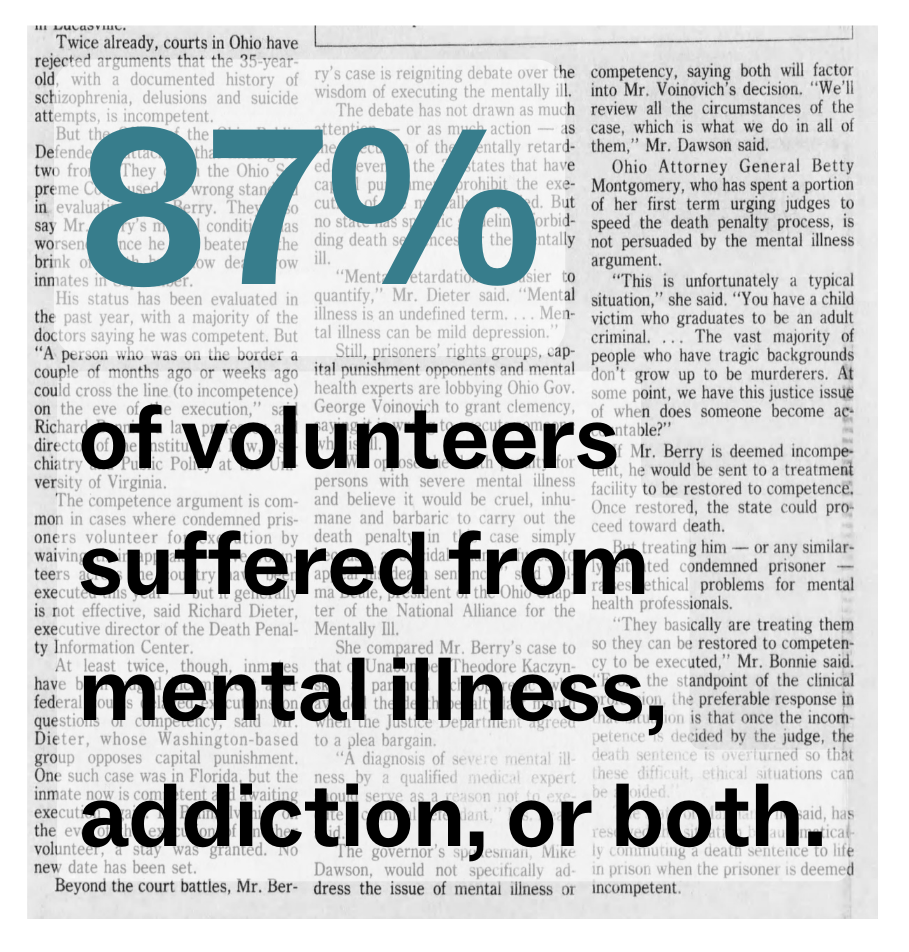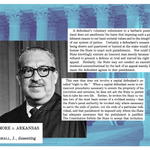
Derrick Dearman first told his mother that he wanted to die when he was four years old. On October 17, he was executed by the state of Alabama, becoming the 20th person executed in the United States this year and the 165th in the modern era to “volunteer” for death. A new analysis by the Death Penalty Information Center shows that despite falling rates of death sentences, executions, and public support for the death penalty, the number of death-sentenced prisoners waiving their appeals and choosing execution remains high — ten times higher than suicide rates among the general public. An estimated one in ten modern executions are the result of the prisoner’s choice. Given that the legal bar for “competence” to waive capital appeals is extremely low, scores of people have been executed on their own request despite evidence of severe mental illness and other serious constitutional concerns about their convictions and death sentences.
Mr. Dearman is a case in point. He struggled with severe depression and suicidal ideation since he was a small child and was diagnosed with numerous mental health conditions including bipolar disorder with psychotic features, PTSD, and neurocognitive disorder. On the day he killed five members of his girlfriend’s family, he had not slept for six days and was high on methamphetamines, hearing voices that told him people were “after” him. Earlier this year, he sent a handwritten letter to state officials requesting an execution date. The United States Supreme Court has held that it is unconstitutional to execute a person who cannot rationally comprehend their punishment and the reasons for it, adding that the practice “simply offends humanity.” However, without conducting a competency hearing, an Alabama court permitted Mr. Dearman to waive his appeals. He asked the state to be executed, and the state obliged.
In 2005, Cornell Law School Professor John Blume published a seminal study on volunteers titled “Killing the Willing: ‘Volunteers,’ Suicide, and Competency.” In an analysis of volunteers from 1977 – 2003, he found that 88% had struggled with mental illness and/or substance abuse. Volunteers did not split evenly along race or gender lines: 85% were white males, despite that group representing only 45% of those on death row. Black men represented 43% of death row but only 3% of volunteers.
DPI analyzed volunteers in the twenty years since the study and concluded that Professor Blume’s findings hold true today. Of the 165 people executed at their own request since 1977, 87% battled mental illness, substance abuse, or both. About 46% of people sentenced to death in the modern era have been white men — but they make up 84% of volunteers. The last ten volunteers, going back to 2016, have all been white men. Meanwhile, 41% of modern death sentences have been imposed on Black men, but they represent only 5% of volunteers (eight total). The difference in volunteer rates for white and Black men, compared to their death sentence rates, is strongly statistically significant. Statistics for women are somewhat more consistent: about 2% of people sentenced to death have been women of any race, and 2% of volunteers have been women (only three total, all white).
These statistics match the demographics of suicide in the United States. Studies consistently show that over 90% of suicide victims suffered from mental illness and/or substance abuse. Serious mental illnesses like bipolar disorder, schizophrenia, and depression increase the risk of addiction to drugs and alcohol, and together the conditions compound to create further instability and vulnerability to suicidal ideation. According to the American Foundation for Suicide Prevention, white men accounted for 68.5% of suicides in 2022, despite being only 30% of the population, and had a suicide rate of 23.8 per 100,000 — the highest of any individual race-gender group. Black men, despite facing higher social and economic adversity, had lower suicide rates. Researchers are “puzzled” by the racial disparities but have identified increasing social isolation, higher gun ownership rates, and a perceived “loss of status” as possible explanations for the suicide rate among white men in the general public. It is not clear which factors contribute to the overrepresentation of white male volunteers on death row.
Assisted suicide is legal in only a handful of states, and typically available only for terminally ill patients who must meet strict procedural requirements. Death-sentenced prisoners, though, may request execution dates even when they are physically healthy and openly suicidal. Supreme Court Justice Thurgood Marshall, who vehemently opposed the death penalty, wrote in 1979 that “the Court has permitted the State’s mechanism of execution to be triggered by an entirely arbitrary factor: the defendant’s decision to acquiesce in his own death.” He deemed this process “nothing less than state-administered suicide.”
Measurements of the “volunteer rate” on death row, compared to suicide rates on death row and amongst the general public, lend support to this critique. Professor Blume calculated that the volunteer rate on death row was approximately 150 per 100,000 people for the period 1977 – 2002.1 Using his method, we found that the volunteer rate through 2024 has seen only a modest decrease, to approximately 137 per 100,000. This rate is about ten times higher than the rate of civilian suicide, which stands at 14.2 per 100,000 people as of 2022. However, it matches the rate of suicide on death row — 129.7 per 100,000 — nearly perfectly. Research also shows that when executions increase, suicides on death row decrease — suggesting that some suicidal prisoners may volunteer for execution instead of attempting to take their own lives.
The data show “disturbing similarities between persons who commit suicide and those who volunteer for execution,” Professor Blume argued. “Volunteers resemble those who commit suicide in ways that are extremely unlikely to be attributable to chance.”
For Scott Dozier, the choice was clear: whether by execution or suicide, he wanted to die. “I just would rather be dead than do this,” he told The Marshall Project. Mr. Dozier had spent ten years on Nevada’s death row before he sent a letter to a Nevada judge on Halloween 2016, saying he was “of sound mind” and asking to be “put to death.” Like most other volunteers, he was a white man with a history of mental health conditions and substance abuse. But the state hadn’t executed anyone in a decade and could not find execution drugs. Officials proposed a new cocktail of fentanyl, Valium, and the paralytic drug cisatracurium, prompting lawsuits from advocacy groups as well as Mr. Dozier’s attorneys, who worried about its use on their other clients. Several pharmaceutical companies also accused Nevada of fraudulently obtaining their drugs for use in executions. Against his wishes, Mr. Dozier received several stays of execution while courts debated the new protocol. On January 5, 2019, he died by suicide.
Similarly, Aubrey Trail is seeking execution in Nebraska despite the state claiming not to have lethal injection drugs. “My message to whoever is listening is simple: ‘You gave me the death penalty so now use it,’” he wrote in a letter to a newspaper. Mr. Trail had attempted suicide in front of the jury at his trial by cutting his throat with a razor blade.

Several factors may contribute to the higher rate of suicide and volunteerism on death row, including harsh conditions, isolation, the psychological weight of a death sentence, and the fact that people sentenced to death are more likely to suffer from addiction and mental illness. Researchers use the term “Death Row Syndrome” to describe the hopelessness and situational depression experienced by people facing execution. In many states, the history of the death penalty is a history of volunteers: in four states, the only prisoners executed have been volunteers, and volunteers were the first to be executed in 15 states and by the federal government.2 The first man executed in the modern era of the death penalty, after the Supreme Court authorized new death penalty statutes in 1976, was volunteer Gary Gilmore. He had tried to kill himself at least twice while awaiting execution, and was shot to death by firing squad just two months after his death sentence.
The “volunteering” phenomenon also creates serious ethical issues for defense attorneys, who have professional and ethical obligations to fight to save their client’s life. Defense attorneys note that nearly all death-sentenced prisoners at some point express hopelessness about their appeals and consider volunteering for execution. However, most change their minds, in part due to the advice and encouragement of their attorneys. In this study, DPI has defined a volunteer as a prisoner who takes affirmative steps to hasten their execution, including waiving appeals, asking for an execution date, or instructing their attorneys not to file end-stage litigation.
One of the largest concerns about volunteering is that it allows executions to occur despite lingering constitutional questions about the volunteer’s conviction and death sentence. Because the courts only require a minimal finding of legal “competence” to waive appeals in a capital case, many volunteers have gone to their deaths with unresolved constitutional claims such as intellectual disability, severe mental illness, powerful mitigation evidence that a jury has never heard, and even innocence. Some of these claims could have resulted in the prisoner’s ineligibility for the death penalty, but the law permits the volunteer’s desire for execution to take precedence. “Society’s independent stake in enforcement of the Eighth Amendment’s prohibition against cruel and unusual punishment cannot be overridden by a defendant’s purported waiver,” wrote Justice Marshall in dissent in Lehnard v. Wolff (1979). But the court asks only whether a person has a rational and factual understanding of the consequences of waiving his appeals.

Stephen Vrabel was found incompetent to stand trial and treated in mental hospitals for five years before he was sentenced to death. He suffered from schizophrenia and believed his attorneys were spies working against him. Yet a court found him competent to waive his appeals, and he was executed on July 14, 2004. That same year, courts approved execution for volunteer David Hocker, who was diagnosed with bipolar disorder and had cut off his testicles on death row. On September 24 this year, just a few weeks before Mr. Dearman was executed, Travis Mullis was put to death after volunteering in Texas. He had been found competent to waive his appeals after a lifetime of suicide attempts and severe mental illness, including bipolar disorder. In his final statement, he explained that he “took the legal steps to expedite to include assisted suicide.”
While there is evidence of a growing national consensus against executing people with serious mental illness, there have been few successful legal or legislative reforms to protect them. In recent years, Ohio and Kentucky passed bills prohibiting the execution of people who suffered from a serious mental illness at the time of their crimes, regardless of whether a court deems them “competent” for execution. Similar bills have been introduced in a dozen other states but none have passed.
If the execution of Joseph Corcoran proceeds on December 18, 2024 will have the highest number of volunteers executed in six years. Sentenced to death in Indiana for the murders of four people, including his brother, Mr. Corcoran has a long history of serious mental illness. He has been diagnosed with schizophrenia, with symptoms of hallucinations and delusions, and multiple experts have testified that he is incompetent. He believes that the prison guards are torturing him with an ultrasound machine. However, the Indiana Supreme Court held that his “past evidence of mental illness” is not enough to block his execution.
For more information, see DPI’s Execution Volunteers list or search for volunteers in DPI’s Execution Database.
American Foundation for Suicide Prevention, Suicide Statistics, accessed October 23, 2024; Abigail Brooks, A death row inmate wrestled with guilt and addiction before his execution, NBC, October 18, 2024; Equal Justice Initiative, Alabama Executes Derrick Dearman, October 17, 2024; Amaris Encinas, ‘I am guilty:’ Alabama inmate Derrick Dearman asks for death sentence to be carried out, USA Today, October 16, 2024; Juan A. Lozano and Michael Graczyk, Man executed for molesting, stomping infant son to death in 2008 waived right to appeal sentence, ABC, September 24, 2024; Rebecca Green, State sets Dec. 18 execution date for Joseph Corcoran, 89.1 WBOI, September 12, 2024; Tim Evans, Indiana wants to execute Joseph Corcoran. Here’s why his attorneys say it would be wrong, IndyStar, July 12, 2024; Joseph Margulies, Volunteering to Die: A Client’s Agony and a Lawyer’s Dilemma, January 8, 2024; Leah Roemer, Under Recent State Legislation, Courts in Ohio and Kentucky Rule Four Men Ineligible for Execution Due to Serious Mental Illness, Death Penalty Information Center, November 2, 2023; Paul Hammel, Supreme Court rejects appeal from death row inmate who attempted suicide during his trial, Nebraska Examiner, November 10, 2022; Austin Frakt, What Can Be Learned From Differing Rates of Suicide Among Groups, The New York Times, December 30, 2020; Jill Harkavy-Friedman, Ask Dr. Jill: Does Mental Illness Play a Role in Suicide?, American Foundation for Suicide Prevention, February 7, 2020; Maurice Chammah, The Volunteer, The Marshall Project, January 18, 2018; Christine Tartaro and David Lester, Suicide on Death Row, 61 Journal of Forensic Sciences 1656 (2016); Meredith Martin Rountree, Volunteers for Execution: Directions for Further Research into Grief, Culpability, and Legal Structures, 82 University of Missouri-Kansas City Law Review 295 (2014); Kristin Houlé, Mental Illness and the Death Penalty Resource Guide, Texas Coalition to Abolish the Death Penalty (2008); Amy Smith, Not “Waiving” But Drowning: The Anatomy of Death Row Syndrome and Volunteering for Execution, 17 Public Interest Law Journal 237 (2008); Panetti v. Quarterman, 551 U.S. 930 (2007); Amnesty International, The execution of mentally ill offenders (2006); Amy Oberlin, Hamilton native: ‘I want to die,’ KPC News, February 28, 2006; John H. Blume, Killing the Willing: “Volunteers,” Suicide and Competency, 103 Michigan Law Review 939 (2005); Staff, Volunteer executed for killing girlfriend, daughter, Morning Journal, July 15, 2004; State v. Vrabel (Ohio 2003); Gilbert G. Otero and Lawrence G. Brown, Prosecutors’ Perspective on California’s Death Penalty, California District Attorneys Association (2003); Amnesty International, The illusion of control: “Consensual” executions, the impending death of Timothy McVeigh, and the brutalizing futility of capital punishment (2001); Ann W. O’Neill, When Prisoners Have a Death Wish, L.A. Times, September 11, 1998; Ford v. Wainwright, 477 U.S. 399 (1986).
-
In Connecticut, New Mexico, Oregon, and Pennsylvania, the only people executed have been volunteers. The first two states have since abolished the death penalty, and the latter two have imposed moratoria. In Nevada, 11 of 12 executions have been of volunteers. Volunteers were the first to be executed in those five states, as well as Delaware, Idaho, Illinois, Indiana, Maryland, Ohio, South Dakota, Utah, Virginia, Washington, and the federal government.



